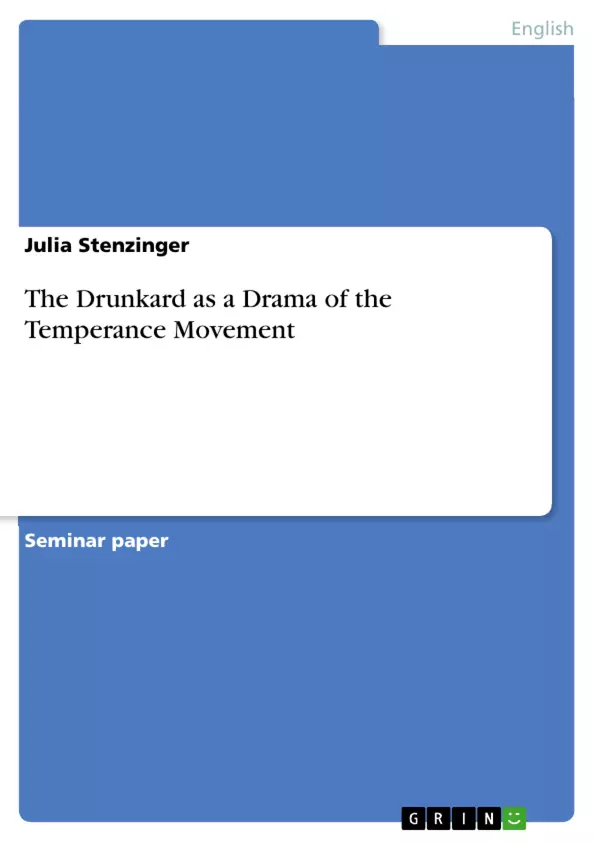Introduction
The Drunkard by William Henry Smith was first staged at the Boston Museum in 1844 and shown 144 times within one year. Being a mass media, the theater reached a large audience and the drama was a great success. At the time the drama was staged, the temperance movement was at the peak of its popularity and success. Today the Boston Museum is regarded as the birthplace of American temperance drama. In 1850, when the play had already achieved national recognition, B. T. Barnum staged The Drunkard at the famous American Museum on lower Broadway. On October 7th 1850 the audience was able to watch the 100th consecutive performance of the play. “Barnum’s production of The Drunkard heralded the entry of temperance narratives into mainstream theatre and immediately became the standard against which all other temperance dramas were measured” (Frick 113).
In this paper I will first present a short historical survey of the temperance movement. At a time when drinking alcohol was part of every day life and the negative consequences that resulted from alcohol abuse were severe and obvious, the goal of the temperance movement was to achieve a social reform in the long term. The aim was to put an end to moral decline, crime, poverty and diseases. Alcohol addicts should be persuaded to stop drinking and supported in their effort. They should sign the pledge and abstain from alcohol.
The melodrama The Drunkard or The Fallen Saved is an excellent example of the way the theater was used as a means to present the social, moral and personal consequences of intemperance to the audience. The main focus of this paper will be on the criticism of alcohol abuse in The Drunkard. By close reading I will analyze how Edward Middleton’s and his family’s life changes due to the fact that Edward starts drinking too much alcohol and becomes an addict. But, as the title suggests, the drama also shows that alcohol addicts can be saved and rebuild their lives if they are strong enough and stop drinking. Thus, The Drunkard is a perfect example of the theatricalization of temperance propaganda. The theater was the ideal means to communicate the temperance message of abstinence, and the audience was entertained and received a moral lesson at the same time. The Drunkard was “by far the most prominent and influential […], a play destined to become one of the most popular and best-known temperance dramas of all time” (Frick 113).
Table of Contents
- I. Introduction
- II. Main part
- 1. The temperance movement
- 2. Criticism of alcohol abuse in The Drunkard
- 2.1. Edward's life before he drinks alcohol
- 2.2. Edward slowly becomes addicted to alcohol
- 2.3. Edward's life as an alcohol addict
- 2.4. Edward at the peak of his addiction and his rescue
- 2.5. Edward's life after he signed the pledge
- III. Conclusion
Objectives and Key Themes
This paper aims to provide an analysis of the temperance movement and its influence on the popular theatre of the 19th century, specifically focusing on William Henry Smith's play, The Drunkard.
- The rise and impact of the temperance movement in early America
- The portrayal of alcohol abuse and its social consequences in The Drunkard
- The use of theatre as a tool for moral reform and social commentary
- The characterization of Edward Middleton, the protagonist, and his journey of addiction and redemption
- The role of the theatre in shaping public opinion and influencing social change
Chapter Summaries
- I. Introduction: The chapter introduces The Drunkard as a popular temperance drama of the 1840s, highlighting its historical context and success. It outlines the paper's objective to analyze the criticism of alcohol abuse presented in the play. The chapter also introduces the main protagonist, Edward Middleton, and his journey of addiction and recovery.
- II. Main part: This section dives into the historical background of the temperance movement in America, detailing its origins, goals, and strategies. It examines the shift from informal social control to organized efforts to curb alcohol consumption. The chapter highlights the impact of the temperance movement on society and its role in shaping public opinion on alcohol abuse.
- 1. The temperance movement: This chapter provides a historical overview of the temperance movement, discussing its development from informal social controls to national organizations like the American Temperance Society (ATS). It explores the different strategies employed by the movement, including moral suasion and the formation of temperance societies for different social groups. The chapter also discusses the broader impact of the temperance movement on other social reforms.
- 2. Criticism of alcohol abuse in The Drunkard: This chapter examines the play's portrayal of alcohol abuse and its consequences through the character of Edward Middleton. It analyzes the character's transformation from a seemingly harmless drinker to an addict and the impact of his addiction on his family and social life.
Keywords
The primary focus of this paper is on the temperance movement, its historical context, and its impact on early American theatre. The key themes explored include alcohol abuse, social reform, moral suasion, theatricalization of temperance propaganda, and the character of Edward Middleton in The Drunkard.
- Citation du texte
- Julia Stenzinger (Auteur), 2004, The Drunkard as a Drama of the Temperance Movement, Munich, GRIN Verlag, https://www.grin.com/document/52166



